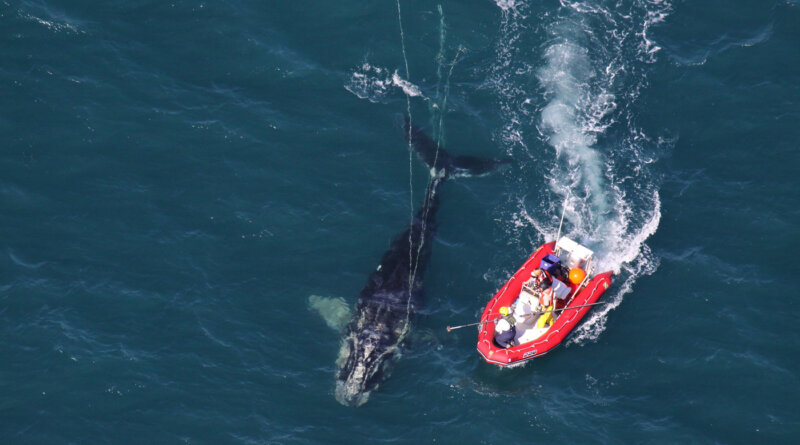Entanglement In Fishing Gear Limits Whales’ Growth : NPR

Scientists from NOAA Fisheries Service approach a young North Atlantic right whale in order to disentangle it. New research shows whales with severe entanglements in rope and fishing gear are experiencing stunted growth, and body lengths have been decreasing since 1981.
NOAA News Archive 011811
hide caption
toggle caption
NOAA News Archive 011811

Scientists from NOAA Fisheries Service approach a young North Atlantic right whale in order to disentangle it. New research shows whales with severe entanglements in rope and fishing gear are experiencing stunted growth, and body lengths have been decreasing since 1981.
NOAA News Archive 011811
North Atlantic right whales now grow smaller than they did 40 years ago, and new research suggests a leading cause is the damage human activity inflicts on the critically endangered mammals.
The findings, published today in the journal Current Biology, reveal that when fully grown, a North Atlantic right whale born today would be expected to be about one meter shorter than a whale born in 1980. Currently, full-grown members of the species average 13 to 14 meters in length (43 to 46 feet).
“The first inkling that we had came from the folks who were collecting the data in the field, where, as the story goes, they saw what looked to be a really young whale, a calf, or maybe one- or two-year-old,” said Joshua Stewart, a postdoctoral researcher with the National Oceanic and Atmospheric Administration’s (NOAA) Marine Mammal and Turtle Division and lead author of the new study. “But it turns out that they were actually 5-year-old or 10-year-old whales that were smaller than a typical 2-year-old.”
The researchers used high-resolution aerial photographs to track size and body condition over time of 129 right whales. There are only about 366 North Atlantic right whales in existence now, compared to 481 in 2011, the known high for the population in recent years. Their numbers were much higher before commercial whaling brought them to the brink of extinction by the early 1890s. The mammals’ high fat content and buoyancy after death led to their name: whalers called them the “right whales” to kill.

A photo illustration demonstrates how much shorter a North Atlantic right whale born in recent years would be compared to one born years earlier. In each image, the outline shows how long researchers expected each whale to be had it been born in 1981. “It’s just astonishing,” said Joshua Stewart, lead author on the paper.
Madeline Wukusick
hide caption
toggle caption
Madeline Wukusick
The research, with contributions from scientists with the New England Aquarium, Woods Hole Oceanographic Institution, and Oregon State University, indicated that a prime reason for the animals’ recent stunted growth is entanglement in rope and fishing gear.
North Atlantic right whales typically migrate up and down the Eastern seaboard, from Florida to Canada. In recent years, more than half the population can be found from late winter to early spring off the coast of Cape Cod, where they navigate a deadly maze of rope and lobster fishing gear.
Entanglements in the gear can lead to fatal infections, starvation, or drowning. But even when they don’t kill the whales, they can cause long-term harm, the researchers found. When the mammals get caught in human detritus and end up dragging it around, it forces them to expend more energy fighting to survive, instead of growing or repopulating their dwindling species.
“You can imagine if you had a sandbag tied to you and you had to go about your daily business, you’d be burning a lot of extra energy just dragging that sandbag around,” Stewart said.

A North Atlantic right whale in Cape Cod Bay. The callosity patterns on each whale’s head are unique and allow for identification, along with tracking of impacts such as entanglements and vessel strikes, reproductive histories, and ages of individual whales.
John Durban/NOAA and Holly Fearnbach/SR3, authorized by NMFS research permit #17355
hide caption
toggle caption
John Durban/NOAA and Holly Fearnbach/SR3, authorized by NMFS research permit #17355
Not only does entanglement contribute to reduced body size for an individual whale, but female North Atlantic right whales entangled while nursing produce smaller calves. That threatens the repopulation of a species with so few remaining members.
“This is a finding that adds to the grim tale of the right whale,” said Charles “Stormy” Mayo, director of the North Atlantic Right Whale Ecology Program at the Center for Coastal Studies in Provincetown, MA, who did not contribute to the new research. “It’s an extremely important piece of work because it demonstrates not only what we always knew, and that is that entanglement causes death. But in this case, it goes beyond that and confirms what some of the authors have long suspected.”
The stunted growth of the whales coincides with an increasing rate of entanglements. A 2012 study from the New England Aquarium revealed that more than 80 percent of right whales have been entangled at least once in their lives and 60 percent have been entangled more than twice.
“We know from other species of whales, including really closely related southern right whales, that in the case of moms, when you’re giving birth, if you’re smaller and skinnier, then your calf is also likely to be smaller and skinnier,” Stewart said. “Especially as a calf, you’re needing to grow really quickly in those early years, so you could have a lower chance of survival if you’re smaller.”

A North Atlantic right whale that a team of state and federal biologists assisted in disentangling. Since 2017, 46 individual right whales have been found dead or seriously injured. This represents more than 10% of the population, according to NOAA.
NOAA News Archive 123110
hide caption
toggle caption
NOAA News Archive 123110

A North Atlantic right whale that a team of state and federal biologists assisted in disentangling. Since 2017, 46 individual right whales have been found dead or seriously injured. This represents more than 10% of the population, according to NOAA.
NOAA News Archive 123110
He added: “We also think that if you’re shorter, you can’t pack on as much of an energetic reserve as a longer whale can. Their gas tank is smaller, and so that means that if you deplete a lot of that reserve when you’re, let’s say, nursing a calf … you might have to wait longer between pregnancies.”
Researchers acknowledge that entanglements do not explain all of the reduced growth. Other factors might be climate change, collisions and noise from ships, and the shifting availability of tiny crustaceans called copepods, their primary food source.
Researchers are now trying to establish whether other, less-studied large whale species and marine mammals are suffering from similar declines in growth.
In response, conservationists say fisheries managers need to better regulate the crab and lobster fisheries, whose vertical lines to traps on the seafloor are considered the primary culprit in entanglements. One potential answer is greater investment in the development and testing of ropeless fishing technology.
Representatives of the lobster industry say they have been unfairly blamed for entanglements and insist that more research is needed to determine the source of gear found wrapped around these whales before further regulation drives them out of business.
Researchers, however, say there is no time to wait.
“We are in a very deep hole with right whales,” Mayo said. “Really, the species can’t tolerate any further impacts or its future really is sealed.”




